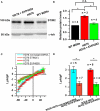STIM2 Mediates Excessive Store-Operated Calcium Entry in Patient-Specific iPSC-Derived Neurons Modeling a Juvenile Form of Huntington's Disease
- PMID: 33604336
- PMCID: PMC7884642
- DOI: 10.3389/fcell.2021.625231
STIM2 Mediates Excessive Store-Operated Calcium Entry in Patient-Specific iPSC-Derived Neurons Modeling a Juvenile Form of Huntington's Disease
Abstract
Huntington's disease (HD) is a severe autosomal-dominant neurodegenerative disorder caused by a mutation within a gene, encoding huntingtin protein. Here we have used the induced pluripotent stem cell technology to produce patient-specific terminally differentiated GABA-ergic medium spiny neurons modeling a juvenile form of HD (HD76). We have shown that calcium signaling is dramatically disturbed in HD76 neurons, specifically demonstrating higher levels of store-operated and voltage-gated calcium uptakes. However, comparing the HD76 neurons with the previously described low-repeat HD models, we have demonstrated that the severity of calcium signaling alterations does not depend on the length of the polyglutamine tract of the mutant huntingtin. Here we have also observed greater expression of huntingtin and an activator of store-operated calcium channels STIM2 in HD76 neurons. Since shRNA-mediated suppression of STIM2 decreased store-operated calcium uptake, we have speculated that high expression of STIM2 underlies the excessive entry through store-operated calcium channels in HD pathology. Moreover, a previously described potential anti-HD drug EVP4593 has been found to attenuate high levels of both huntingtin and STIM2 that may contribute to its neuroprotective effect. Our results are fully supportive in favor of the crucial role of calcium signaling deregulation in the HD pathogenesis and indicate that the cornerstone of excessive calcium uptake in HD-specific neurons is a calcium sensor and store-operated calcium channels activator STIM2, which should become a molecular target for medical treatment and novel neuroprotective drug development.
Keywords: EVP4593; Huntington's disease; STIM2; calcium; induced pluripotent stem cells; neurodegeneration; store-operated calcium channels.
Copyright © 2021 Vigont, Grekhnev, Lebedeva, Gusev, Volovikov, Skopin, Bogomazova, Shuvalova, Zubkova, Khomyakova, Glushankova, Klyushnikov, Illarioshkin, Lagarkova and Kaznacheyeva.
Conflict of interest statement
The authors declare that the research was conducted in the absence of any commercial or financial relationships that could be construed as a potential conflict of interest.
Figures





Similar articles
-
Molecular Components of Store-Operated Calcium Channels in the Regulation of Neural Stem Cell Physiology, Neurogenesis, and the Pathology of Huntington's Disease.Front Cell Dev Biol. 2021 Apr 1;9:657337. doi: 10.3389/fcell.2021.657337. eCollection 2021. Front Cell Dev Biol. 2021. PMID: 33869222 Free PMC article. Review.
-
Enhanced Store-Operated Calcium Entry Leads to Striatal Synaptic Loss in a Huntington's Disease Mouse Model.J Neurosci. 2016 Jan 6;36(1):125-41. doi: 10.1523/JNEUROSCI.1038-15.2016. J Neurosci. 2016. PMID: 26740655 Free PMC article.
-
Manifestation of Huntington's disease pathology in human induced pluripotent stem cell-derived neurons.Mol Neurodegener. 2016 Apr 14;11:27. doi: 10.1186/s13024-016-0092-5. Mol Neurodegener. 2016. PMID: 27080129 Free PMC article.
-
Dysregulation of Neuronal Calcium Signaling via Store-Operated Channels in Huntington's Disease.Front Cell Dev Biol. 2020 Dec 23;8:611735. doi: 10.3389/fcell.2020.611735. eCollection 2020. Front Cell Dev Biol. 2020. PMID: 33425919 Free PMC article. Review.
-
Patient-Specific iPSC-Based Models of Huntington's Disease as a Tool to Study Store-Operated Calcium Entry Drug Targeting.Front Pharmacol. 2018 Jun 29;9:696. doi: 10.3389/fphar.2018.00696. eCollection 2018. Front Pharmacol. 2018. PMID: 30008670 Free PMC article.
Cited by
-
Cell Reprogramming to Model Huntington's Disease: A Comprehensive Review.Cells. 2021 Jun 22;10(7):1565. doi: 10.3390/cells10071565. Cells. 2021. PMID: 34206228 Free PMC article. Review.
-
STIM2 is involved in the regulation of apoptosis and the cell cycle in normal and malignant monocytic cells.Mol Oncol. 2024 Jun;18(6):1571-1592. doi: 10.1002/1878-0261.13584. Epub 2024 Jan 17. Mol Oncol. 2024. PMID: 38234211 Free PMC article.
-
STIM and Orai Mediated Regulation of Calcium Signaling in Age-Related Diseases.Front Aging. 2022 Apr 19;3:876785. doi: 10.3389/fragi.2022.876785. eCollection 2022. Front Aging. 2022. PMID: 35821821 Free PMC article. Review.
-
The STIM1/2-Regulated Calcium Homeostasis Is Impaired in Hippocampal Neurons of the 5xFAD Mouse Model of Alzheimer's Disease.Int J Mol Sci. 2022 Nov 26;23(23):14810. doi: 10.3390/ijms232314810. Int J Mol Sci. 2022. PMID: 36499137 Free PMC article.
-
Differential expression and roles of Huntingtin and Huntingtin-associated protein 1 in the mouse and primate brains.Cell Mol Life Sci. 2022 Oct 17;79(11):554. doi: 10.1007/s00018-022-04577-8. Cell Mol Life Sci. 2022. PMID: 36251080 Free PMC article.
References
LinkOut - more resources
Full Text Sources
Other Literature Sources
Research Materials

